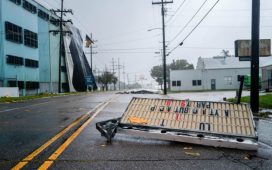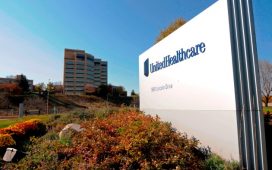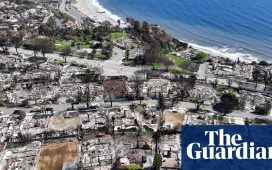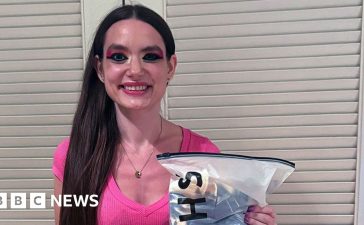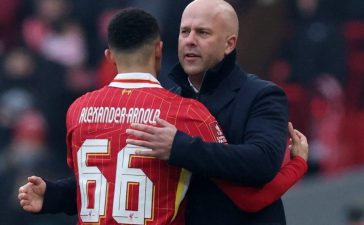As I headed back to New York City from my parents’ new home in New Jersey earlier this year, I had a feeling Papa was going to die. It wasn’t just that he had been bedridden for weeks, but something in the way he desperately wanted me to leave made me suspicious.
It’s as if he didn’t want me to witness what was about to happen.
My parents moved from Texas to New Jersey in December to be closer to me, their eldest daughter. After my father had a devastating stroke two years before, I’d helped care for him while trying to keep my journalism career afloat – but something had to give.
Papa, who despised the frigid winters and high taxes of the east coast, finally made the agonizing decision to leave his beloved San Antonio home on the golf course so I could go back to work, to my friends, to a life not completely bound to sickness.
On move-in day, Christmas Eve, the Salams called the Garden state “home”.
That period of bliss was short-lived. My suspicions were confirmed on 6 February, the day before he died. The doctors had been trying to figure out why my father was in severe pain for a week. Was it blood or some other fluid in his lungs? Was his heart failure getting worse? In the end, the reason didn’t matter; his organs were rapidly shutting down, and I was told to decide on a time to remove his breathing device and inform the rest of my family.
I couldn’t believe it. Just a few days earlier, we were laughing about how ugly this hospital was compared with previous ones he had stayed in. In retrospect, I don’t know why I thought he would survive – this man had already endured a second heart attack in this ancient and inefficient regional hospital in Trenton, and doctors had told us to prepare for the worst: another, probably final, cardiac event.
Two years ago, at Methodist hospital in San Antonio’s medical center, my sister led the way to the neurointensive care unit. Papa was in the last room on the left. I parted the curtain encircling his hospital bed. He was fast asleep, looking as he always did when he passed out on the couch while watching TV at home.
I gently nudged him. He slowly opened his eyes and looked confused, probably at the sight of me, here in Texas. Then, his face broke out into a huge smile that I could now see was extremely crooked, a legacy of his stroke.
He kissed my hand. “You look great, just like Sylvester Stallone,” I reassured him, leaning over to hug him. It was then that I realized he wouldn’t be able to reply. His voice was gone – a common symptom immediately following a major stroke.

When a blood vessel in someone’s brain is compromised, the life they lived just before that moment ceases; today would mark the beginning of the rest of our lives.
My father’s stroke instantly aged him, and me. My biggest concern prior to this moment was deciding whether to ghost the guy I was going out with, or let him down over text. No longer was I a twentysomething with an unremarkable life.
Khursheed Salam was not unlike most fathers, particularly south Asian fathers. He valued hard work and education above all else. If you didn’t bring home an A – or at least a B in my case – you might as well make sandwiches at the nearest 7-Eleven.
He emigrated from a small, boring town in West Yorkshire in the United Kingdom to New Jersey to marry my mom, Kausam, in the 1980s. They settled in Houston. For most of my childhood, Papa worked in finance for Metro, the city’s transportation authority. He went to work downtown every weekday morning and came home just before dinner, in time to evaluate our homework and yell at us when it was wrong or showed lack of effort.
A punctual person who cherished routine and structure, he was risk-averse and a fastidious saver, to the point where he often didn’t allow himself as much fun as he could have. But behind the facade of the reliable breadwinning head of household, Papa was a simmering pot of stress, always worrying he wasn’t doing enough for his family.
In retrospect, I see that behind every outburst was severe anxiety: a fear that his kids would become lazy high school drop-outs and drug addicts that would lead to him losing his hard-earned savings, putting his family out on the street.
His health problems, I now recognize, were exacerbated by stress. He suffered from diabetes, high blood pressure and, eventually, congestive heart failure. It probably didn’t help that he smoked half a pack of Marlboro cigarettes every day on the patio behind our house – one of the ways he dealt with his anxiety.
But I didn’t know the extent of his chronic ailments until he was lying flat and semiconscious in a hospital bed.
The nurses told me to come back at 8.00 the next morning for rounds, when the entire medical team gathered to discuss the patient’s prognosis and update family members.
The big breath of relief we took when we learned my father would survive his traumatic brain injury was quickly followed by a series of logistical and emotional obstacles.
The recovery process after a stroke is arduous. In some severe cases, it never ends, and is made worse by having to navigate the US healthcare system. But such is the state of post-stroke care in the US: we have the greatest number of top rehabilitation hospitals in the world, but accessing those facilities is a bewildering and competitive process.
Whether stroke patients have insurance – and what kind – can determine the trajectory of their recovery and future quality of life. It can mean the difference between walking and using a wheelchair for the rest of their lives.
It can also make the difference between living and dying.
Strokes predominantly affect people over 65, most of whom have federal Medicare coverage if they are US citizens or eligible legal residents. But government health insurance has substantial shortcomings, and for those with less coverage – or, even worse, those without insurance – their story is sadder.
Every year, more than 795,000 people in the US have a stroke. It’s a cause of serious long-term disability in the US, reducing mobility in more than half of survivors ages 65 and older.
There are two types of stroke: ischemic, when a blood vessel is blocked, and hemorrhagic, when it bursts. On 22 March 2022, my dad had an ischemic stroke, or, as one doctor colorfully put it, “a massive, massive, massive stroke”.
Treatment is limited: medicine, possibly surgery, and a hail Mary (or an “Inshallah”, as my mother would say.)
Treatment begins the moment emergency medical technicians make contact. The hope is that they rush a patient to the primary stroke hospital in their town or city – if one exists. An inventory of stroke centers in the US found that among 5,533 emergency departments, only 2,446 (44%) are stroke centers, according to data provided by healthcare non-profit the Joint Commission.
In the ER, staff immediately administer a medicine called a tissue plasminogen activator (tPA), which helps break up any blood clot. Those who receive tPA are more likely to recover fully or have less disability than patients who do not receive the drug, according to the CDC.
But here’s the kicker: tPA can only be given within three hours of a stroke. In rare instances, if it can’t be given in time or if the drug was unsuccessful, the blood clot must be surgically removed in a procedure called a thrombectomy.
Papa became one of these rarities: at the San Antonio Methodist hospital emergency room, the tPA did not work but, by some miracle, he qualified for the surgery.
He didn’t look like it, but he was lucky. Many hospitals, even those deemed primary stroke hospitals, don’t offer thrombectomies. According to researchers at the University of Texas Health Science Center at Houston, only 19.8% of the population can access a stroke center capable of performing one within a 15-minute ambulance ride.
Even if a hospital has the capacity to perform the surgery, that’s not a guarantee that a stroke victim can get it. It has to be performed within six hours of the onset of symptoms.
And patients with private insurance in particular – like my dad, who was covered by Aetna through his employer – were more likely to undergo a thrombectomy, according to a 2021 study, while those uninsured or under-insured had more limited access.
In short, your insurance – or lack thereof – helps determine the type of care you receive.
“When someone experiences a stroke, you’ve lost a very big part of what you’re able to do that keeps you independent,” said Dr Ganesh Asaithambi, a vascular neurologist and the lead author of a study on thrombectomies in acute ischemic strokes. “The best chance of recovery is not only the rehabilitation, but getting to the hospital as fast as possible,” he explained.
If a patient survives, a months-long hospital stay begins that involves sleepless nights, hysterical crying, delusional laughter, and numbness – for both the patient and their caregivers.
Rounds made me feel like I was a disgraced politician surrounded by a press gaggle, except I was being hounded by medical professionals, not journalists. After the neurologist, pulmonologist, cardiologist and chief nurse read aloud their notes about Papa, the attending physician for the neurocritical care unit, Christopher Burdick, asked if I had any questions.
Although I had been taking notes on my phone, I didn’t know what to ask. I was completely lost. I could only muster the confidence to ask: “Will he survive?”
Although I hated it at the time, Burdick’s candor was grounding.
“I don’t know. But I hope so and you should, too. Have faith.”
Every day after that, I came to rounds better prepared. Memorizing the medical lingo slung at me by various professionals, I compiled a long list of questions.
“How much of the brain was affected? Which parts of the brain? What is the likelihood the functions performed by these parts will return? How can we achieve maximum recovery?“
Dr Burdick explained that large chunks of Papa’s brain were compromised, particularly on the left side. These areas told him how to walk, talk, eat and even see.
But amid all the bad news, Dr Burdick offered a morsel of good news, which proved an effective technique to placate distressed, sleep-deprived caregivers like me and my mother. He explained that although the parts of the brain that lost blood flow during a stroke can never recover, the brain has an incredible capacity to find alternative “pathways” that allow people to perform some of the functions they lost.
Even though he was calling me on his drive to work just a week prior, now Papa could not stand, speak or swallow, and had trouble seeing – but there was a small hope he could do these things again one day as his brain rewired itself.
Throughout his stay, therapists tried to help Papa stand and swallow. Every day, a speech pathologist would perform a swallow test. And every day, I hoped he would be able to eat applesauce without any of it lingering in the wrong passageway.
From rattling off important historical dates and mathematical equations at the drop of a hat to trying to consume food typically reserved for a baby, Papa had fallen far.
If he continued to flunk the swallow tests, he would be at risk of pneumonia and would need a feeding tube. I could not accept my dad being fed through a device in his stomach, living without the foods he loved so much. I willed him to swallow. And after he failed test after test, the speech pathologist told me “he swallowed like a champ” on his last day, just before being discharged.
Next challenge: Papa was in no condition to come home yet, but he was too “stable” to remain in the hospital.
Typically, after a stroke, doctors recommend that patients move from the traditional hospital to a rehabilitation hospital to receive more intense physical, occupational and speech therapy several times per week – if their insurance covers it. But even those lucky enough to have coverage may be physically unable to handle the demands of a robust program.
Papa had premium private insurance through his job, but he was visibly weak and didn’t appear cognizant of his surroundings. I realized this observing a game he played with his speech therapist which involved picking up the object she named. She placed an apple and a plastic spoon on the table in front of Papa. “Pick up the spoon,” the therapist said. She repeated the instruction several times. Finally, Papa picked up the apple.
The hospital caseworker had told me and my mother that Papa would be best suited to a “skilled nursing facility”, since he probably could not handle the work a rehabilitation hospital required.
She implied he wasn’t good enough for an exclusive, elite rehab hospital because he couldn’t perform in therapy multiple times a day, every weekday.
I was enraged. “If you’re telling me my dad is going to a nursing home, you are sorely mistaken,” I remember saying. “We are not leaving until he is admitted to not just any rehab hospital, but the best in the country. And don’t worry, we can wait.”
I called the best stroke rehabilitation hospitals in the country: NYU Rusk, Kessler in New Jersey, and TIRR Memorial Hermann in the Texas medical center in Houston. Patient and empathetic therapists there confirmed I was doing the right thing by pushing for Papa to go to a rehab hospital.
Flying would be dangerous and incredibly expensive, since he would have to be boarded on a stretcher. So I set my sights on Houston and prayed for a bed to open.
The caseworker finally came bearing good news: TIRR had a vacancy. I rejoiced as if I’d just been admitted to a prestigious university or won a car in a shopping mall raffle. It was a light in a dark, weeks-long tunnel of despair.
We were grateful my dad still had private insurance. Papa had the first two weeks of his stay covered by insurance, and he would be reassessed every week after that.
In total, he eventually received two full months of inpatient rehabilitation at a world-class hospital – the equivalent, for someone with a new brain injury, of winning the lottery.
Being a patient advocate is a full-time job. In fact, it’s an actual paid position at many hospitals. These people help families navigate the hospital’s processes, such as communicating with doctors, making sure insurance companies approve necessary procedures, or even acting on behalf of the family in a complaint against the hospital.
But many people, like me at the time, don’t know these people exist or how to utilize them if they do.
So I took on the role myself. I met frequently with the new hospital caseworker assigned to us to make sure his insurance would continue to cover his rehab stay, and stayed alert just in case I had to correct a nurse about my dad’s medical history. When a physical therapist said my dad looked too tired for therapy, I argued he was fine, knowing that pushing him was what he would want me to do. Once I yelled at someone who assumed my father couldn’t speak English, probably because he was a brown man, and explained that he had aphasia. Then I had to explain what aphasia is to said person, despite their medical background.
In retrospect, I probably wouldn’t have even let anyone else advocate for my dad’s health. I fought for my dad the way I knew he would for me if our roles were reversed, so this often resulted in verbal spats with hospital administration and expletives I probably could have kept to myself. On two occasions following disagreements on treatment, I was asked to leave and cool down.
I am my father’s daughter, after all.
I often forgot to eat, so I spent spare moments cobbling a meal together from the hospital vending machines or ordering the same grilled cheese and apple from the cafeteria where I became a regular. During these “breaks”, I’d obsessively consume articles from medical journals about how to maximize recovery after a stroke or call a friend and sob over the phone. Once or twice, I slept overnight in the very uncomfortable chair in my dad’s room when I knew he was particularly anxious or distressed.
My new schedule didn’t leave room for my responsibilities at my actual job, but thanks to my generous employer, I took a long leave of absence to stay with my dad in the hospital. I told my mother to finish teaching her classes for the semester since academia is a far less forgiving industry, and I became my father’s designated primary caregiver and had medical power of attorney.
But not every stroke survivor has a family member able to go to bat for them. And even if a doctor does plead for more therapy for a patient, it’s far from guaranteed an insurer will cover it.
Nneka Ifejika, a physician, professor, and researcher of physical medicine and rehabilitation and neurology, chairs the American Stroke Association advisory committee’s rehab and recovery subcommittee.
Accessing inpatient acute rehabilitation after a stroke “changes everything”, she told me. “If I don’t advocate diligently, persistently, and insistently for my patients’ access to appropriate post-stroke care, it’s not going to happen,” Ifejika said. “I know for a fact that if I intervene earlier, I have the potential to change the trajectory of their recovery.”
This spells bad news, since the World Health Organization found the likelihood of having a stroke has increased 50% worldwide since 2005.
There are several reasons for this increase. In addition to a growing population of the older people most at risk, UCLA Health also blames the rise in obesity and the decrease in food quality.
Even with good insurance, we hit expensive barriers. Before Papa could be formally discharged from the Methodist Hospital in San Antonio, we had to have him transported to his new rehab hospital. But with all the tubes and wires Papa was connected to, we couldn’t just put him in the backseat of the car and drop him off. He needed to travel by a private ambulance, the cost of which I was able to negotiate down to the bargain price of $1,000 by guilt-tripping our hospital caseworker and the partner ambulance company.
My mom began packing a suitcase for my dad’s indefinite stay in Houston.
On a Saturday morning in the great room of Columbia University’s Teachers College, people hang around a table offering pastries and coffee. Everyone looks like old friends, talking and laughing.
Bernadine Rae Gagnon, assistant director of Columbia’s Clinic for Communication Disorders and Placement, started a therapy program in 2005 to provide free support for both survivors and their caregivers – whom this group calls “co-survivors”.
She invited me to observe.
A woman in a bright yellow shirt sits down with a plate of fruit and a Danish. Barbara Salahuddin-Grant is here because her son, Robin, suffered a stroke in 2009. She doesn’t look it, but she’s 88. Unsurprisingly, she calls caregiving “tiresome”.
Her son was teaching at a school in Killeen, Texas, when he called his mother in the middle of the day to say he felt dizzy. As Robin lost the ability to form words, a mother’s instinct kicked in.
“Call 911,” she instructed Robin’s colleague. “He’s having a stroke.”
A long journey through various hospitals in Texas and eventually a stay at a post-acute rehabilitation center outside Austin followed.
Years later, Robin’s stroke symptoms persist, Salahuddin says. At 68, he no longer works. Like my dad did, he suffers from aphasia, a communication disorder that causes loss of the ability to either understand or express speech, depending on the type. There’s no cure for it, but improvements are possible with extensive speech therapy. Often, insurance coverage ends long before a stroke survivor has recovered, or even made substantial progress. This especially hits home for those living with aphasia because speech will always be a struggle, but the amount of speech therapy insurance programs cover is finite.
“Medicare and Medicaid only cover a specific number of days in inpatient services and continued care for outpatients. The rules and regulations are so onerous that many can’t understand how to access these services,” Gagnon explained to me. “Insurance companies vary. Survivors need to be on the phone with these insurance companies too. This is very difficult when you already have a communication deficit.”
The other co-survivors sit around and swap stories of recent difficulties and achievements. Lala is here to support her mother, a soft-spoken woman in a hijab. She animatedly narrates a story about how “Mommy” is taking additional therapy online. Mommy, a former professor, used to speak six languages. Now, Lala just hopes she can converse with her at all.
Barbara has an older son in his 70s who suffered a stroke several years ago. Because he was left completely paralyzed, Barbara could not care for him, forcing her to place him to live in an assisted living facility in the Bronx. She plans on paying for it with the proceeds from selling his old apartment.
In spite of Barbara’s tribulations, she keeps the faith. She is a deacon, after all, at Grace Baptist church in Mount Vernon, New York, just north of the Bronx. When I asked her how she keeps going, her response was simple: “By the grace of God.”
The Texas medical center in Houston was beautiful: fountains and flowers everywhere you looked. Inside the brown-brick building, a long hallway led to the main rehabilitation gym.
As I wheeled Papa down the hallway, I noticed framed pictures of alumni with traumatic brain injuries. Gabby Giffords, the former congresswoman shot in the head by a gunman, was a patient. For some reason, that made me feel better.
Papa had a simple room shared with a twentysomething kid who had sustained brain damage from a four-wheeling accident.
Papa’s first meal arrived in the evening. Because of his special diet due to his dysphagia, or inability to swallow, all of his food was the texture of mashed potatoes. Papa and I both stared at the tray in confusion.
Corn was ground into a paste and then molded to resemble corn on the cob, like a cruel joke. Meat was also a paste, though it was hard to tell if it was chicken or beef. Dessert was a sugar-free pudding.
I spent every day observing Papa’s sessions with a physical therapist, Justin Hoang, a guy maybe a few years older than me. We became fast friends, which was nice since I didn’t have a social life any more. I was there when Papa was spontaneously able to kick his right leg back and forth, to Justin’s delight. I even joined in his music therapy with Chynah and Danielle, speech therapists who told me singing has been proven effective for aphasia patients because the unaffected side of his brain could analyze melody, allowing Papa to carry a tune.
I told them he loved the Beatles and Pink Floyd so we spent an hour each weekday singing Here Comes the Sun and Another Brick in the Wall at his bedside. The therapists were right: Papa’s speech improved slowly over his eight-week stay.
Next, my dad moved to a post-acute rehabilitation and skilled nursing facility down the street from his house. Insurance would cover five days of therapy a week here.
Family members weren’t allowed to stay overnight or be present during his therapy – which should have been the first red flag. Papa was alone in a new and unfamiliar environment.
I noticed the next red flag at dinner the next day, where about 20 patients each sat at their own small table. My sister Mariam and I brought food my mom made and put through a food processor. He was still on a moist diet.
But at his table, I noticed a plastic plate of macaroni and cheese and what looked like breaded chicken, something any speech pathologist would forbid for risk of choking.
I couldn’t take the plate away fast enough and demanded of the nurse on call to know why he was given food he couldn’t swallow.
“Oh, we’ll fix that,” she assured me.
They never did. Papa was ever the observant Muslim, with the exception of smoking like a chimney and rarely praying. But he had never eaten pork a day in his life, and when Mariam returned the next day, he was unknowingly about to eat pork chops.
We took Papa home that same day.
Crippling anxiety set in when I contemplated Papa’s return home. We would now be on our own.
By the time Papa came home, he could swallow a little better and was on a “minced” diet, though still unable to eat normally. He was able to stutter through a few short sentences and could stand on his feet with assistance from an object or another person. He was nowhere near being able to walk.
My parents’ San Antonio home was not wheelchair accessible. I began by ordering a portable wheelchair ramp on Amazon for $155 – a fraction of what my family ultimately spent to make their two-story house a livable place for a wheelchair user with a lingering severe brain injury.
We hastily hired Benny, a general contractor, to knock down a shower stall and build a bigger one fitted with handrails and a detachable shower head. I also bought a shower chair.
In between trips to Home Depot and arguing with his wife over the phone about working late nights, Benny got the job done.
The total cost of Extreme Makeover: Wheelchair Edition: $1,250.
But that’s a steal considering what most people spend to retrofit homes for newly disabled loved ones. A checklist created by the National Association of Home Builders details every part of an ideal wheelchair-accessible home compliant with the Americans with Disabilities Act (ADA), including the floor plan, exterior, entries and thresholds. The average amount spent on home renovations for people with disabilities is $4,403.
I couldn’t access or even locate all my dad’s bank accounts, and my mother didn’t have the slightest clue either – a fact she was now regretting. She was a relatively present parent, always educating us beyond the school curriculum and making sure we were fed and clothed. But my dad had always made every single financial decision in our home, down to which grocery store we shopped at. (I made a mental note to never enter into a hyper-traditional relationship like my parents.)
But the intense stress I felt during that period had less to do with finances than with the change I was finally coming to terms with: my father was no longer my provider, my rock. I was in charge.
The life change for stroke survivors is well documented; less talked about is the impact and burden on caregivers like me, my mom and my sister.
By the time my father came back home in his new condition, it was summer – my mom, an English professor, was finally on a break from work. But now she was suddenly a nurse’s aide, helping Papa transfer from the wheelchair to the shower and guiding him on how to brush his teeth with his left hand. She was cooking more than ever, following diet guidelines in pamphlets provided by hospital doctors.
Mariam, 21, was organizing pills like she worked in a pharmacy. Her puzzled look as she sat at the kitchen table confronting an array of orange pill bottles gave me pause, but I had no choice but to trust that she had it handled. I had far too much else on my plate.
When he arrived home, Papa had to take at least 20 pills. Atorvastatin, 80mg. Carvedilol, 3.125mg. Clopidogrel, 75mg. Isosorbide Mononitrate, 30mg. Jardiance, 25mg. And the list went on.
I was on the phone with Aetna, his mortgage holder and several law firms that help families quickly apply for social security disability benefits. I was investigating where exactly Papa kept all his money, so I could pay the mounting bills. There was a 401(k), a 401(a) and a few other types of accounts I had never heard of.
I compiled a comprehensive color-coded spreadsheet titled “Papa’s info” in Google Sheets with tabs for bills, accounts, his medication list and a daily log for blood pressure and blood sugar readings. However ridiculous, it gave me a sense of control over an uncontrollable situation.
“The high level of emotional distress among caregivers of stroke patients suggests that many caregivers have unmet needs,” a 2010 study on the impact and burden of caregiving for long-term stroke survivors concluded. “Community services need to focus attention on the neuropsychological aspects of stroke patients and the social functioning of caregivers who support them.”
We didn’t need a team of researchers to tell us that. Mommy’s health was deteriorating. She complained of shooting pains in her hands and arms, probably from loading the heavy wheelchair into and out of the car. She became sleep deprived, forcing herself to stay awake in case my dad’s blood sugar dropped or if he needed help in the bathroom.
I convinced her to seek help for her mental health. We found a nearby therapist with good reviews online, who had a kind face. I told her how hard it had been for my mom since my dad became disabled overnight and explained in great detail the panic and anxiety that set in once the realization hit that he would probably need help until the day he died, which seemed a lot sooner now.
“Are you sure you don’t need someone to talk to?” she asked me half-jokingly.
She was right: I also began therapy for the first time a few weeks later. Moments, however fleeting, of sobbing and shortness of breath aren’t normal, she assured me. I was having panic attacks and I needed something stronger than an edible to put me at ease.
Months later, I started taking an antidepressant and haven’t stopped.
“This is a huge event in this patient and in their family’s life,” said Ifejika, of the Stroke Association. “There’s never a conversation about the provision of caregiver training, support – all of those things that are done in the inpatient rehab facility arena.”
In the US, healthcare outcomes are often dependent on policy and paperwork required by insurance companies – not physicians. But Ifejika is pushing for change.
Access to inpatient rehab used to involve a level of documentation that required three steps, “but one of the steps got taken out during the pandemic”, she said of the cumbersome paperwork insurance companies require from doctors.
“It’s the same thing for outpatient therapies. There have been numerous times where I’ve wanted to extend a patient’s outpatient therapies, particularly patients with aphasia, because you need more time to recover your speech.”
But insurance companies, and Medicare and Medicaid, cap the number of therapy sessions available to someone who just had a stroke, and often, their doctors and therapists say it’s not nearly enough.
“There’s no set path of recovery. That’s not how this works. That’s not how the brain works,” Ifejika said.
Which type of Medicare a patient has also affects coverage. Traditional Medicare offers better access to post-stroke rehab. “As long as they meet the admission criteria, they can go to rehabilitation soon as they are available,” Ifejika explained. But about half of beneficiaries now choose a Medicare Advantage plan, “which I call Medicare Disadvantaged populations”, she said. “There are significant limitations on access to care.”
For example, Medicare Advantage has up to 72 hours to decide whether the patient should go to inpatient rehab. But with “three more days in the hospital, you have a higher likelihood of lying in bed, developing complications from immobility, and a high likelihood of getting infections”, she said. “Depression, anxiety – all those things start to build up more because you’re literally waiting for an insurance company to give you access to the care that the medical team agrees that you need.” Private insurers also follow that policy.
One of my dad’s therapists, Joy, worked for Rehab Without Walls, a company that provides therapy at a patient’s home. It’s an ideal and convenient solution, but not everyone is eligible. Rehab Without Walls does not, for example, accept Medicare.
I know this because when assessing my dad at our dining room table for the first time, Joy exclaimed: “Thank God you don’t have Medicare!”
I remember feeling grateful my dad hadn’t yet turned 65.
More than a year after leaving the hospital, Papa worked tirelessly to make himself better again. I don’t know a more stubborn person. But he continued to lose weight, looking so fragile as he completed therapy each day as if it were his job. I missed the conversations we had had about world politics, his advice for my career (it was always “just go to law school”). His speech did eventually improve, but we never could get back to the same long conversations.
Papa never lived to see 65, but he did survive two years past his catastrophic stroke. I still got what I consider bonus time with my father while friends of mine had lost parents without any warning.
I resented it at first – leaving New York to go back to Texas, the place I had tried so hard to leave – to figure out the logistics of our new situation. Only for him to die just after moving across the country.
The stress was an overwhelming hell at the time that broke me, but I wouldn’t have done anything differently. I bonded with my father in a way most people don’t get to in adulthood. I held him while he was in pain, fed him when he couldn’t eat by himself, and we laughed together when he had what would ordinarily be an embarrassing accident in the bathroom. I watched more English Premier League games and episodes of The Big Bang Theory than I ever expected to in my life.
And while his random brain injury-induced rage tired us all, he still managed to crack so many jokes about his tragic situation – like laughing at other people who had to park further away while he had a handicapped sign on the car, or pretending to hit us with the cane he practiced walking with.
His death has quieted my usually loud personality. I often have to remind myself I will never see or talk to him again and then feel the weight of a freight train hit my chest upon the realization. I am struggling to find purpose beyond the scope of work now, and look on at friends whose dads are still alive with envy. My father will never see me get married, or meet his grandchildren. He won’t get to spend all the money he saved for retirement or benefit from the social security he paid into for years. I’ll soon turn 29 without getting a “happy birthday” phone call or text from my dad.
A few weeks after the funeral, I shot up out of a deep slumber at around 4am. I had what I can only describe as a dream, but it felt so real.
We were back in the hospital room where he died, but this time the walls weren’t the shade of depression-gray. They were teal – one of his favorite colors. It was as if we were presented with an opportunity to say a proper goodbye, versus the rushed, confused chaos that actually was his death.
This time, he wasn’t intubated so he could speak. He was himself again.
We rejoiced tearfully, as if we both knew we had been given this chance and it wouldn’t last long. I hugged him and could feel him. Sobbing, I told him I loved him so much. “I know,” he said.
“I’m OK,” he told me, placing his hand on his chest.
As he sat upward in a hospital bed, surrounded by family, laughing, he announced it was time for him to leave and casually waved goodbye as if we would all meet again soon.

